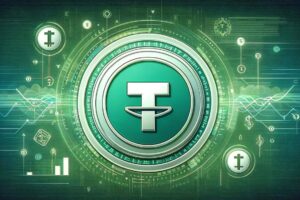USDT (Tether) – one of the popular stablecoins – attracts the attention of cryptocurrency users with high liquidity. However, it also comes with risks that need to be considered.
1. What is USDT?
USDT, also known as Stablecoin, is a type of digital currency pegged to the US dollar at a 1:1 ratio and fully backed by the Tether Limited reserve. Users can buy, sell, and store USDT through cryptocurrency exchanges or digital wallets.

With over 10 years of development, USDT has become one of the most popular and largest stablecoins in the current market, with a market capitalization of $139.82 billion, equivalent to approximately 35,096.03 trillion VND.
2. What is Bitcoin?
While there isn’t a specific definition of Bitcoin, according to the European Central Bank, Bitcoin is considered a type of cryptocurrency. Simply put, a cryptocurrency is a type of digital currency not centrally managed, issued by software developers who typically control the system. It is used and accepted as payment within a specific virtual community.

Bitcoin can be understood as a form of currency recognized and used within a community or organization. These communities create Bitcoin for circulation, especially for exchanging goods and services.
3. Comparison between Bitcoin and USDT
3.1 Functionality
USDT (Tether) and Bitcoin are two popular and widely used cryptocurrencies in the market. So what are the differences between these two cryptocurrencies?
USDT is considered a Stablecoin, pegged to the US dollar and typically used for storing value or conducting transactions with higher stability compared to Bitcoin. It can also be used to purchase other cryptocurrencies, including Bitcoin.
Bitcoin, despite its high value volatility, is seen as a decentralized cryptocurrency, not controlled by any organization. This creates security and transparency for Bitcoin.
3.2 Advantages
With its stability and flexibility, USDT continues to prove itself as a formidable competitor to Bitcoin in the cryptocurrency world. Fixed to the US dollar, USDT offers a significant advantage over Bitcoin – stability. This not only helps minimize risks but also provides a secure option, particularly attractive to investors seeking consistency and security in their investments.
Another notable point is the availability of USDT on many cryptocurrency exchanges compared to Bitcoin. This increases flexibility and ease of buying, converting USDT into other digital assets conveniently and quickly. This convenience not only enhances liquidity but also promotes the widespread use of USDT in the cryptocurrency community.
Moreover, low transaction fees are also an advantage that USDT aims for. With lower transaction fees compared to Bitcoin, using USDT not only saves costs but also facilitates users to conduct transactions efficiently and save time.

3.3 Disadvantages
Despite bringing many notable advantages, USDT also has some drawbacks that need careful consideration. Among the disadvantages of USDT compared to Bitcoin, the following can be mentioned:
- Decentralization: One of the major weaknesses of USDT is its lack of decentralization compared to Bitcoin. USDT is issued by a private company, Tether Limited, which poses lower levels of control and trust compared to Bitcoin, a decentralized system not dependent on any specific organization.
- Liquidity risk: A significant risk that USDT users may face is liquidity risk. If Tether Limited cannot provide enough US dollars to support all circulating USDT, the value of USDT could suddenly decrease, causing instability and significant devaluation.
Despite these drawbacks, USDT maintains its position in the cryptocurrency market due to its advantages and flexibility. Unlike Bitcoin, USDT is designed to serve the purpose of payment and storing value more stably, providing users with convenience and peace of mind in their trading and investment activities. This demonstrates that, despite its disadvantages, USDT plays an important role in the modern cryptocurrency system.
4. Frequently asked questions about USDT
4.1 Where can I buy USDT in Vietnam?
USDT or Tether is one of the popular stablecoins in the cryptocurrency market. In Vietnam, users can buy USDT on common cryptocurrency exchanges such as Aliniex, Vicuta, Remitano, and many other exchanges.
4.2 How to mine USDT?
Mining USDT is not feasible because all Tether Tokens, including USDT, cannot be mined but are only issued by the company Tether Operations Limited.
4.3 Is USDT considered an Altcoin?
USDT is not classified as an Altcoin. In fact, all Tether Tokens, including USDT, are categorized as Stablecoins, designed to maintain stability and pegged to legal tender such as the US dollar.
4.4 How long does it take to transfer USDT?
The speed of transferring USDT depends on two main factors: the confirmation speed of the Blockchain platform that USDT uses and the number of transaction confirmations required by the exchange. Therefore, the transfer time for USDT is not a fixed number and can vary depending on technical factors and regulations of the specific exchange.
Despite its drawbacks, the stability and flexibility of USDT still maintain its important position in the current cryptocurrency market. Understanding USDT is crucial to leverage all opportunities and avoid unwanted risks. If you need further information or have any other questions, feel free to let me know.















